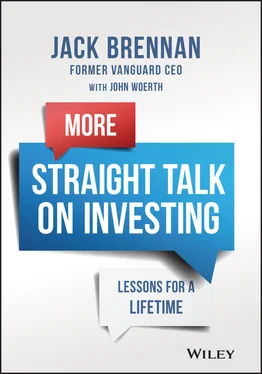Products such as exchanged-traded funds (ETFs) and target-date funds, which were nascent in 2002, have become core investment tools today and offer low-cost, diversified exposure to the global stock and bond markets. Today, the growing number of environmental, social, and governance funds offer an opportunity to align your investing with your values. There are newly popular options, too, for using your money for charitable purposes, such as donor-advised funds.
We have also seen the advent of robo-advisors and other digital money management services. A growing number of start-ups, banks, and asset management firms offer apps featuring asset allocation guidance, investment recommendations, and saving rate suggestions. These digitally delivered services have made financial advice more accessible and affordable.
However, I believe that most investors in the accumulation stage (i.e., saving for retirement or college) can—with some knowledge , confidence , and discipline —manage their investments on their own and not incur the extra costs of obtaining professional advice. Let's consider these three traits for investing success, and I will come back to them again and again. For those near or in retirement, obtaining professional help at a reasonable price is a valuable option for navigating the complexities of maintaining and drawing upon their nest eggs. The options available to obtain that advice at attractive prices—digital, in-person, or virtual—are now more plentiful and convenient.
Regulatory and legislative developments have improved investor protections and disclosures; brought forth new savings options, such as the Roth IRA; and enhanced the inner workings of the financial markets. 529 plans, in their infancy two decades ago, have emerged as the funding and investment vehicle of choice for college savings. There will be additional developments that impact the financial services industry in the years ahead, some of which will benefit individual investors and, unfortunately, some that may not. This is why it is important to stay abreast of things that could impact your investments, as well as changes in your own personal circumstances, that may require changes to your investment program.
What has not changed is the overabundance of information on investing. Entire TV networks are devoted to covering the markets' minute-by-minute movements, accompanied by provocative commentary by personalities and colorful graphics. You don't need a financial SportsCenter to manage your money effectively. In fact, it's more likely to hurt than help you perform that task. Further, the internet and social media abound with advice from self-professed financial experts. Some are legitimate and offer practical guidance. Most do not and actually are a hazard to your financial well-being.
I will share some insights from the mistakes and missteps of professional investors—Wall Street financiers, hedge funds, and university endowments. A short-term mentality, a lack of diversification, and an underappreciation of liquidity, among other things, have tripped up the “smart money” time and time again.
The goals of this book have also not changed. First, this is the type of book that parents give their children when they strike out on their own. Like many of my contemporaries, I wish I had had such a book. In my case, I am looking forward to giving this second edition to my grandchildren.
Second, I want this book to serve as a useful refresher about the basics of sound financial planning and prudent investing. No matter what one's age, sophistication, or experience, a back-to-basics course is always helpful—particularly during difficult times, when conflicting advice typically abounds. On a personal basis, I consider working on this book my own back-to-basics course and a very helpful one at that.
Finally, this book is aimed at helping people to think about their serious money—the dollars that they set aside for long-term goals, such as retirement or the education of their children. Frankly, this book won't do much good for those who are seeking guidance about finding “hot stocks” or tips on how to “play the market.” That is why I will focus on mutual funds and ETFs as your primary investment vehicles.
The simple approach to investing that I present here is not derived from my years in the university classroom, but from the wisdom of many smart minds that I've had the privilege to meet and learn from during my nearly four decades in the investment industry. These include former and present colleagues at Vanguard, the world-class advisors we hire to oversee the Vanguard funds, and other investment professionals, including the managers of college endowments and non-profit organizations with whom I have had the privilege to be associated over the years.
I've also picked up a great deal from friends, family members, and Vanguard retail clients—“Main Street” investors who've navigated the markets and achieved financial success over the long term. There is simply nothing that I enjoy more than being stopped in the grocery store by someone who says “I just want to say ‘thank you’ for what you and your colleagues have done to provide me with a comfortable, secure retirement.” If this book helps you with your financial future, I look forward to running into you at the market!
Jack Brennan
Valley Forge, Pennsylvania
December 2020
In this book, I cite several Vanguard funds to buttress specific investing lessons. These citations should not be construed as endorsements or recommendations. I use Vanguard funds simply because I am more knowledgeable about them than other funds. One of the lessons I hope to impart is that you should never make investment decisions based on incomplete information. If you become interested in one of the funds mentioned here (or any fund or exchange-traded fund, for that matter), consult its prospectus before taking any action.
Note that in the writing of this book, I sought to avoid investment jargon to the extent possible. In the appendix, you will find definitions of investment terms to help you along the way. When warranted, I employ call-out boxes titled Baseline Basicsto make clear terms and concepts that will add to your foundational knowledge. You'll also come across Portfolio Pitfallsidebars, which offer caveats about common investor mistakes and cautions about questionable industry practices. At the end of each chapter, I wrap it all up with In a Nutshell—a bulleted summary of key takeaways.
As you read this book, you'll encounter bolded passages that highlight key, stand-alone investing principles. These principles are condensed and summarized in the Afterwordat the end of the book and serve as a handy compilation should you need to reference it in the future. In some ways, this compilation represents my off-the-cuff response when someone in a social setting—be it on the sideline at a grandkid's soccer game or at a dinner party—is looking for my high-level thoughts on successful investing. I hope you find these CliffsNotes, if you will, useful and practical, too.
Finally, I use a considerable amount of data—market returns, hypothetical examples, and fund performance—throughout the book to support my points. (Due to production constraints, most of the data is cited through December 31, 2019. The addition of 2020 would not substantially alter the long-term data featured in the figures and text.)You need not be facile with advanced calculus, but having some faculty with numbers will help you become a better investor. I also draw on events; some may appear ancient or irrelevant to you. However, the wisdom offered by the past will help make you a sharper and more discerning consumer of investment products and services.
Читать дальше












